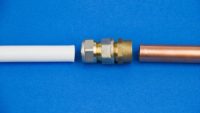Heating, cooling, chiller, water pressure boosting, fire safety and wastewater systems in commercial buildings may incorporate pumps that consume more than 35% of the building’s energy. What if those buildings could unlock energy savings and subsequent cost savings?
According to the EPA’s greenhouse gas equivalency calculator, an estimated 162.9 TWh of untapped energy savings — and $14.6 billion in cost savings — live in expected pump purchases that could be upgraded, leading to greenhouse savings that would represent carbon sequestered by more than 1.9 billion tree seedlings grown for 10 years. It’s equivalent to the CO2 emissions from more than 12.9 billion gallons of gas consumed and a year’s worth of electricity for more than 13 million homes.
The design and implementation of water systems in commercial buildings can affect water and energy conservation. By reevaluating current pump systems and implementing more energy efficient solutions, companies can generate long-term savings without sacrificing reliability.
Energy and cost savings will vary depending on a variety of factors for different settings, but properly selecting pumps and ensuring they have an HI Energy Rating Label will increase the savings. For example, utilizing water pumps with an HI Energy Rating of 50, in a typical mid-sized commercial building using 20 pumps with an average 15-hp rating, you could expect to see a savings of 411,000 kWh per year, or $37,000 per year. In an industrial building using 40 pumps with an average 15-hp rating, you could see a savings of over 1.3 million kWh per year, equating to an approximate savings of $117,000 per year.
These savings can be even more significant when calculated alongside other pump systems within the same building or application, leading to significant cost and energy savings to help meet business and sustainability goals. Determining the right pump to save energy in a given application can be broken down into three general steps.
Step one: Analyze the requirements of a system — not just a single pump
First, it is important to understand that all pumps are selected to meet system requirements — never the other way around. Once the application is determined, engineers can assess criteria, which varies greatly between different uses. For example, a hydronic heating pump intended to circulate water will require different flow rates and attributes than water distribution pumps in residences or businesses.
The energy consumption required for any system depends on the system’s flow rate, pressure (head) and how often the pump(s) are operating.
By reviewing the entire system and not just the individual pump, engineers and specifiers lay the foundation to select the right pump or system for the application and the proper control methodologies to manage the flow of energy and ensure reliability. The most important question to ask at this juncture is how much flow/pressure does the system need and how often does it need it?
Step two: Identify optimization opportunities and plot the curve
To be accurate in the determination of energy consumption, the next step is to evaluate opportunities for efficiency gains in system flow, pressure/head, pump, motor and drive efficiency, along with operating time. In existing systems, the energy requirements can be measured over time as a benchmark to aid in identifying where energy consumption can be optimized.
The time period for this process may need to account for seasonal variations, so an entire year may be needed. In contrast, a batch process for a system’s specific task (e.g. provide 100 gallons per minute (gpm) of water around a reactor to maintain 200° F (for one hour), will be a much shorter benchmark because the periodic operation is known and consistent.
In another example, a building may need more heat or cooling when it is occupied during business hours and less when business is closed. Multiple thermostats in that building may require different flows at different times, meaning the needs can vary on certain days and during different times of day.
To plot the system head curve (how system pressure varies with flow rate) in the system, map how system flow rate and head changes within the system over periods of time. During this process, it is important to understand if and how controls are maintaining the flow and pressure in the system because the control method is typically key to optimizing the system. This will enable decision makers to select the pump based on system requirements.
Then, overlay the pump curve and the system curve to determine if multiple pumps vs. a single pump, and fixed speed vs. variable speed, is needed. For example, a water distribution operation has a different system curve than pumps used for building heating and cooling. Or, if the need is to pump a large volume of water to primarily overcome an elevation difference, variable speed pumping may not be cost effective, but instead a larger low-speed pumping option may be best.
Step three: Energy saving pump selection
Pump system energy consumption is dependent on the system flow rate, head, component efficiencies and operating hours at these conditions. In Figure 1, the output power (Pu) is what the system requires and the input power (P) is what the pump requires. There could be opportunities to reduce the head or flow rate through better control that could reduce the output power and the input power. Understanding the variance in the system curve and resulting operating points allows us to calculate potential savings of new pumps and/or system controls. It’s important to select the best control that meets the varying system demand without artificially increasing the head/pressure or flow rate to do so, and to maintain the operation of the pump(s) at or near the best efficiency point to maximum reliability and system efficiency.
This three-step process is a framework for any decision maker to help evaluate their current system, identify opportunities for improved efficiency and realize energy and cost savings over time to help meet broader sustainability and energy management goals.
To better utilize financial and energy resources, the Hydraulic Institute’s suite of resources and educational products can help evaluate current systems and identify energy efficient pumps or integrated systems with an Energy Rating Label, which helps cities collectively be more sustainable.
Specifiers can visit www.pumps.org/energyefficiency to learn more about Hydraulic Institute’s Energy Rating Program and search the energy rating pump database to find energy-conserving solutions for various settings and applications.



